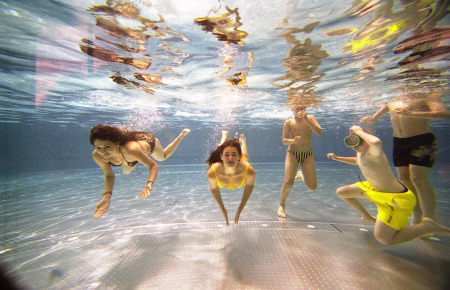Bilz bath
Friedrich Eduard Bilz devoted himself to self-taught studies on naturopathy and a healthy lifestyle. His first book "Das menschliche Lebensglück. A guide to health and prosperity through a return to nature". Its publication earned him a fortune and much recognition.
Bilz converted his house in Oberlößnitz into a sanatorium. Due to the great demand, he had a four-storey Swiss-style spa centre built according to plans by the Ziller brothers. At the turn of the century, his sanatorium with 150 beds was one of the largest of its kind in the Dresden area. Bilz also had hundreds of fruit trees planted, 20 air cabins and several sports grounds laid out. The sanatorium also developed into a cultural centre for the Lößnitz communities with regular open-air concerts and park festivals.
In 1903, Bilz planned the establishment of a public health centre in the Lößnitzgrund. In accordance with his natural healing theory, people of all ages and classes were to be able to move freely there in light swimwear.
The wave pool built in 1912 became a special attraction. Bilz had acquired its centrepiece, the Undosa wave machine, at the International Hygiene Exhibition in Dresden in 1911. Today, the wave machine is considered the oldest machine of its type and is still in operation thanks to a general overhaul in 1998 in the Bilz pool.
With its non-swimmers' pool, wave pool, wave machine and campsite, the Bilz-Bad is without doubt the most beautiful outdoor pool in the city in summer.
From the city encyclopaedia
Bilz-Bad (Meiereiweg 108).
As early as 1903, F. E. Bilz planned the establishment of a public health centre in the Lößnitzgrund; by 1905, he had acquired 9 hectares of land for this purpose and opened Germany's largest "light-air bath" at the time in June of the same year.
In accordance with his natural healing philosophy, people of all ages and from all walks of life were to be able to move freely and exercise there in light bathing clothes. The facility initially consisted of a water basin with an island, 50 air bathing cells and a bowling alley; in the years that followed, the baths, which had been run by Bilz's son Johannes since 1906, were extended several times.
By 1907, there were already 3 bathing pools available, which were supplied with water from specially constructed wells.
A special attraction was the wave pool built in 1912, the centrepiece of which, the Undosa wave machine, was purchased by Bilz at the International Hygiene Exhibition in Dresden in 1911 (refurbished in 1998 and still in operation today as the oldest machine of its type). In addition, sanitary and utility buildings, gymnastics, tennis and ball courts as well as a music pavilion were built.
In 1928, the business, which initially had to contend with strict official regulations and even temporary closure, was also granted a licence to serve beer and dance. From 1931, numerous tenants built small weekend cottages on part of the site, which eventually covered almost 30 hectares.
In 1975, the baths managed by Hans-Joachim Bilz (1922-2001) in the post-war period had to be sold to the town of Radebeul for a minimal price, and from 1992 to 1998, the now much smaller complex was thoroughly renovated.
During Bilz's lifetime, an annual summer festival was held at the Licht- und Luftbad on the initiative of the bathers, with gymnastics and games taking centre stage. During the GDR era, the tenants continued this tradition, and since 1992 the Bilz-Bund e.V. has organised the Bilz-Bad-Fest on the last weekend before the summer holidays together with the regional working group for health promotion, health insurance companies and the municipal baths and leisure facilities company.
Contact us
| Bilzbad pool complex Radebeul | |
| Meiereiweg 108 | |
| 01445 Radebeul | |
| +49 351 8387274 | |
| http://www.bilzbad-radebeul.de | |
|
Mid-May to mid-September daily 9:00 a.m. - 7:00 p.m. June to August daily 9 am – 8 pm |
This might also interest you:
>> Bilz-Camping
>> Bilzweg
>> Treasures from the town archives
>> Town history
>> Histories
>> further sights


